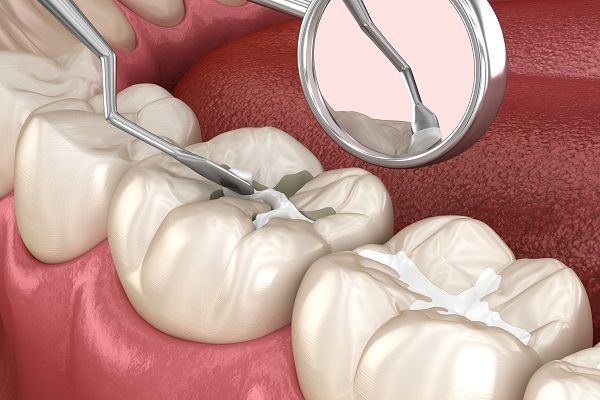What are dental fillings?
A tooth’s structure is compromised when it is damaged by a cavity or fracture. If enough tooth structure has been damaged, a dental filling may provide additional support and visual uniformity throughout the mouth. Only a dentist can tell if you have a cavity that needs to be drilled and filled with a dental filling. A dental filling is a procedure that involves removing decay and repairing the affected tooth by applying a filling. It can last anywhere from five years to several decades, depending on the type of filling used.
Dental fillings are often used to treat cavities, but they can also be used to repair fractured teeth. Some dentists use fillings to restore teeth that have become discolored over time due to prolonged exposure to acidic foods and beverages.
Different types of fillings
Dental fillings come in a variety of materials, but the two most common are amalgams and composites. There are five different types of fillings:
- Amalgam fillings, also known as “silver fillings”, are usually made of a metal alloy that contains several materials, including mercury. It’s a popular option because it’s durable, long-lasting, and less expensive than other options. A standard silver amalgam filling can last for up to 15 years or longer. However, there are potential harmful health effects from mercury vapors and overexposure to mercury has been linked to a variety of health problems. Children under the age of six, pregnant women, people with pre-existing neurological diseases, people who have kidney problems, and people who are sensitive to mercury or other components of dental amalgam fillings should avoid getting these types of fillings.
- Composite fillings, also known as “tooth-colored fillings”, are safer for your health since they are composed of resin or plastic material. They’re designed to blend in with your teeth, so when you smile, they don’t stand out. They are durable, despite not being made of metal. The lifespan of the composite fillings is up to 7 years.
- Ceramic fillings are made of porcelain, which is both long-lasting and cosmetically appealing. This material has a lifespan of more than 15 years and can be on the expensive side. They are more expensive than composite resin fillings but, they are more stain-resistant. Also, the ceramic filling has the disadvantage of being more brittle than the composite filling, so it must be used on larger cavities to avoid breakage.
- Glass ionomer fillings are made up of a glass and acrylic mixture. To protect the teeth from further decay, they release fluoride into them. They’re a bit weaker than other fillings, so they’re best for small cavities near the gum line, rather than being used for cavities on chewing surfaces. They last about 5 years on average.
- Gold amalgam fillings are preferred by some patients over silver amalgam fillings. They have the strength to withstand chewing forces and have a durability of around 10 years. They also require more than one office visit and are more expensive than other materials.
Composite and porcelain fillings are the best and most popular types of fillings. These are aesthetically pleasing and durable, whereas a composite filling gives the damaged tooth added strength and support.
Ceramic fillings are more expensive than amalgam fillings, but many patients are willing to pay more for dental fillings that are safer and more stain-resistant.
When to replace dental fillings?
A dental filling may crack or wear down to the point where it no longer protects the tooth from further decay. The filling may also fall out and require replacement. Most of the time, it is due to normal wear and tears as your filling is put under a lot of pressure as you chew. If your filling is no longer providing sufficient protection for your tooth, bacteria, and small food particles can become trapped under it. Untreated decay can infect the dental pulp, resulting in an abscessed tooth. To avoid further decay, the filling needs to be replaced.
When silver fillings begin to fail, they show visible signs. You might notice the metal leaking out of the filling and into your tooth is causing your teeth to darken. You may also experience heightened sensitivity while eating hot or cold food or drinks. This indicates a loose filling or the presence of untreated tooth decay. When white composite fillings fail, they often result in pain and sensitivity in the area of the filled tooth. There is a throbbing or sharp pain when you bite down. If the decayed filling has caused pulp inflammation, you may also experience a constant toothache.
How to maintain dental fillings?
Can fillings last a lifetime? While dental fillings do not last as long as veneers or crowns, they are a very cost-effective restorative option. You should practice good oral hygiene to keep your fillings in good shape. A healthy dental routine plays a major role in determining how long your fillings will last.
If you want your filling to last longer:
- Brush your teeth at least twice a day with fluoride toothpaste, and floss at least once daily
- Reduce your intake of sugary foods.
- Avoid acidic foods and beverages
- Try not to bite down too hard.
- Schedule cleanings and checkups with your dentist twice a year.
- Drink more water.
If you notice any of the following symptoms, contact your dentist right away:
Are you interested in restoring your smile with a durable dental filling? Contact 24/7 Local Dentist Group today to learn more about the most suitable dental filling option , and how to extend the life of your fillings. Call (833) 220-2448 to schedule an appointment. We have the solution you need to get your smile back in shape. Get started here!










